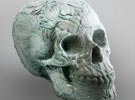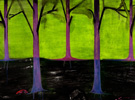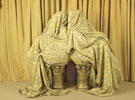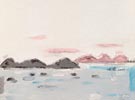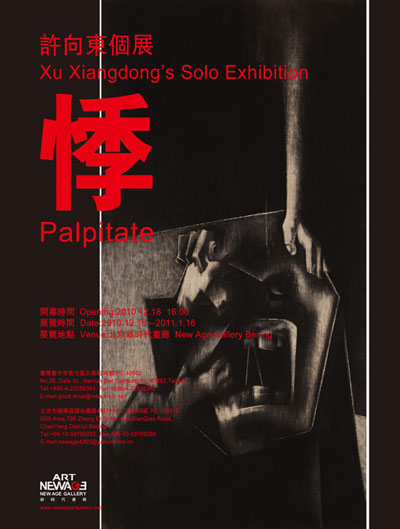
展览时间:2010-12-18 ~ 2011-01-16
展览地点:新时代画廊
参展艺术家:许向东
开幕时间:2010-12-18 16:00
展览介绍:
许向东,任教于中央美术学院版画系。几十年的教学实践,使他全身心沉浸于艺术语言的研究、探索与创新之中。正因为对东方、西方艺术造型语言、各自文化体系的深刻研究与理解,对艺术造型语言本身的执着探索,他试图建立一种新的艺术造型语言体系。他的作品面貌,似乎远离了所谓的当代艺术,但也正是这种远离,使他保持着清醒和独立,使他的艺术呈现出一种另类的风格,这在某种意义上,也走向了更“当代”的艺术之路。
早在2007年底,许向东以展览主题“气形”,先后在北京新时代画廊和中央美术学院美术馆举办个展。这两次个展,第一次集中而全面地向公众展示了他这些年来执着不懈的艺术创作、艺术探索。展现出他独特的艺术理念与表现手法:他直接以木板做为独立的艺术语言材料,强调了木板自身特有的表现特性;木板成为艺术表现和展示的媒介,木板画在他这儿,回到了它自身所应具有的纯粹审美意涵;以锯条工具顺木材肌理进行创作,展现出木材自身的肌理美感;突出艺术造型中一种“虚空”、“负形” (注:绘画物象客观实体 [肉眼所见者,为“正形”、“实象”]之外的,是“负形”、“虚象”。他认为:眼睛“观审”的客观存在的万物,都沉浸于大气、宇宙之中,它与周围形成一种气的、有机的联系,事物的“形”并不是一个孤立存在的纯客观形,而是与周围的一切形成一种有机的联系,包括大气、宇宙;并且,在中国传统文化中,在中国人的心里,“气”,不仅仅是指空气或宇宙自然之气,它还是万物自身及其循环化生的根本。“气”是维系生命、自然、社会、天道的基本物质,是在中国人对生命深切体验基础上产生,并以气化运行阐释宇宙中生命活动的规律。所以,当我们试图在绘画中表现万物之时,我们不只是去关注再现物象表面的可见实在形体及其边缘,而更应该去关注物象与气、物象与大气间的一种共存、共生关系,强调一种隐性的“负形”或“气形”的存在,甚至万物自身及其循环化生之气的存在。以此,赋予对自然、宇宙、生命的深切体悟)的尝试和探索,画面在黑色的混沌氤氲中生成着丰富的“形”和“象”;木板作品的“板”,不仅允许而且需要发挥大平面的“空”,他研究从“大形体大结构”入手,发挥“近距离审视”原则,传达出强烈的迫近感,强烈的整体气势和视觉张力。这些是他的创新,也是他长期从事中央美术学院木版工作室教学工作以来,对木刻版画、造型艺术不断研究和探索的结果。
本次个展,将再集中呈现他三年多来艺术创作的持续和推进。展览主题是“悸”,悸本义为震惊、恐惧、惶恐等之意。在此次展览中,名为“悸”,突出了在今天全球化背景下,东西方文化在艺术中产生的令人震惊的碰撞,作品画面语言及其“形”、“象”产生的令人震撼的效果;同时,作品体现出自然、生活给予人类(艺术家)心灵的震惊、震撼,强大的情感力量倾注于作品之中。
这些即将展出的作品,承载着他艺术新的探索与创新。他通过研究中国古代传统绘画与西方现代架上艺术,两者之间的不同与相似之处,深悟架上绘画几百年来具有无穷无尽的探索止境的原因。他在前期艺术造型语言探索的基础上,进一步意识到:一,作品中“实象”与“虚象”,需同时并存;二,它们虽同时存在于作品中,但是“虚象”,似乎具有更重要的地位,它是艺术家想要表达的内在意念、心象和主要意旨;三,正是由于“虚象”的存在,使得作品画面层次,及其释读意义上,变得丰富而饶有趣味;四,正是由于“虚象”的存在,在架上绘画所构成的四边形限定中,具有强烈的形式构成感与节奏韵律感,潜在地达到符合视觉审美的习惯和标准。这使他的作品呈现出一种即抽象又具象的效果,形象也变得富有“厚重”、“雕塑”感;画面更具有强烈的形式构成美感和节奏韵律感。
许向东在艺术造型语言上的探索与创新,他选择独特的木板材料作为这种造型语言的载体,进一步发挥利用木板自身的材质效果,充分发挥黑白在传统绘画中的功能,在艺术界是独一无二的。相信本次展览,将带给人们一次“悸”动而震撼的感受,带给人们新的视觉享受和艺术启示。
展览主题:悸——许向东木刻版画个展
开幕时间:2010年12月18日 下午4:00
展览时间:2010年12月18日—2011年1月16日
展览地点:北京 新时代画廊
北京市朝阳区酒仙桥路4号 798中二街D09区
电话:+86-10-59789282
传真:+86-10-59789285
E-mail:newage4355@yahoo.com.cn
网址:www.newageartgallery.com
As a teacher at Printmaking Department, Central Academy of Fine Arts, Xu Xiangdong has been entirely devoted to study, exploration and innovation in art language in the past decades. He aims to build a new system of plastic language in art out of his in-depth research and deep understanding of the East and the West, particularly their respective plastic language and culture plus his single-minded pursuit of art language itself. His works, viewed as a whole, seem to be aloof from the so-called contemporary art, but it is such distance that keeps him alert and independent, thus allowing his art production a unique style, making him all the more “contemporary”.
As early as the end of 2007, Xu Xiangdong held at Beijing New Age Gallery and Art Museum of Central Academy of Fine Arts his exhibitions under the title of Qi Form, which, for the first time, offered the public a full view of his painstaking effort in art creation and study, his unique understanding and treatment of art in particular. Board, used as a direct and independent means of art expression, got its expressive particularity fully displayed. It had actually become a medium of art expression and display. With him, board Painting regained its due pure aesthetic significance. With saw blade, he made full use of the beautiful wood texture by creating images following the natural patterns,highlighting “emptiness” and “negative form” in plastic language. (“Positive form” and “real image” refer to the objective existence for painting and what goes beyond them are “negative form” and “virtual image. He believes that what our eyes “contemplate” in the universe is in nature and cosmos, relating to its surroundings, including air and the cosmos, in an organic way in the form of Qi. The “form” of a matter is not a purely objective and isolated one. Moreover, “Qi”, in Chinese traditional culture, and to Chinese people as well, is the basis of everything and its own eternal cycle. As the fundamental substance to maintain life, nature, society and the divine order, it is based on the Chinese’s experience of life and their interpretation of the law of life in the universe through the movement of “Qi”. As a result, while presenting everything in the universe, we concern ourselves with more than its visible superficial form and boundary, and we have to instead focus more on the co-existence and symbiosis between image and Qi, image and the atmosphere, and giving emphasis to the invisible “negative form” or “form of Qi”, and every substance along with its Qi from its cycle. In this way we show our deep understanding of nature, the cosmos and life as well.) The paintings generate rich “forms” and “images” in the black chaos. The “board” does not only allow but also require vast “emptiness”, so the artist creates a strong sense of imminence, overall momentum and visual tension by starting with “big forms and big structure” and applying “the principle of close look”. The originality comes form his persistent curiosity about printmaking and plastic art in his teaching career.
The coming solo exhibition will be a presentation of his progress in the past three years as an artist. As is suggested in the title “palpitate” which means shock, fear and even terror, the exhibition is intended to show the shocking conflict in art when Eastern art comes into contact with the Western counterpart amid globalization. The pictorial language and its “forms” and “images” will also bring startling effect. Moreover, the work is a strong emotional embodiment of the amazement and shock that nature and life bring to humanity (artists).
The works to be presented are proofs of his pioneering spirit in art and his pursuit and innovation. By study Chinese traditional painting and Western easel painting, their similarities and differences, he found out the reason why easel painting has always offered great room for study. Based on his experience in his previous study of plastic language, he made several discoveries. Initially, a “real image” and a “virtual image” co-exist in a work. Secondly, the “virtual image” seems to be more important of than the other, for it is the concept, mental image and principal motif the artist aims to convey. Thirdly, the “virtual image” adds more to the layout and significance of a work. Lastly, in the confine of the quadrangle of the easel, the “virtual image” is capable of strong sense of composition and rhythm, potentially conforming with the habit and satisfying the standard in visual aesthetics. His work thus takes on an effect that is both abstract and concrete, with the images becoming more intense and more “sculpture-like”, striking the audience with strong composition and rhythm.
As an artist, Xu Xiangdong is by all means unique no matter in terms of his exploration and innovation in plastic language, his choice of board as medium for his plastic language to make use of its property as material, or his exploitation of the function of white and black in traditional painting. We have every reason to believe that his solo exhibition will bring the audience new visual enjoyment and inspiration in the form of “palpitating” and shock.
Exhibition Listing on Dec of NEW AGE GALLERY
Theme: palpitate--Xu Xiangdong’s Solo Exhibition
Opening: Dec 18th, 2010, 4:00pm
Date: Dec 18th 2010—Jan 16th 2011
Venue: Beijing New Age Gallery
8502#, D09 Area, 798 Zhong Er St., No.4 Jiu Xian Qiao Road, Chao Yang District, Beijing. PC: 100015
Tel: +86-10-59789282
Fax: +86-10-59789285
E-mail: newage4355@yahoo.com.cn
Web: www.newageartgallery.com
- 2011-04-30 ~ 2011-05-30出窍记·缪晓春个展
- 2011-04-29 ~ 2011-05-20静中人Figures of Silence —Michel Madore
- 2011-04-30 ~ 2011-05-14黑白
- 2011-05-28 ~ 2011-07-28四重奏——孟昌明水墨荷花作品展
- 2011-05-28 ~ 2011-06-24“远与近”意大利当代著名艺术家作品展
- 2011-05-28 ~ 2011-07-02底下有石头:杨心广个展
- 2011-05-21 ~ 2011-06-20湖滨诗境──Celest生态摄影展(续展)
- 2011-05-21 ~ 2011-06-05缓行——十二位八零后艺术家
- 2011-04-28 ~ 2011-06-05观天悟道——张国龙艺术巡展
- 2011-05-28 ~ 2011-07-10诺特·维塔尔:激浸







